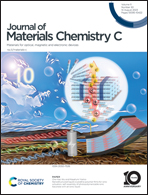MAPbBr3−nXn (X = Cl, I) single-crystal narrowband photodetectors for potential application in traffic light recognition†
Abstract
A narrowband photodetection system that can specifically distinguish green, yellow and red light has potential application in intelligent transportation systems. In this work, a series of MAPbBr3−nXn (X = Cl, I) single-crystal films with controllable thickness have been grown through space-limited inverse temperature crystallization. Filter-free narrowband photodetectors with peak responses at 505, 590 and 620 nm, corresponding to the green, yellow and red of traffic lights, are successfully achieved through the charge collection narrowing mechanism. The as-fabricated narrowband photodetectors demonstrate superior performance, with full width at half-maximum all less than 35 nm, a maximum responsivity of 182 mA W−1, and specific detectivity of 9.68 × 1010 Jones. Finally, a traffic light recognition assembly based on the three narrowband photodetectors is constructed. The photocurrent of the photodetector is approximately five to ten times that of the interference from other light sources, indicating good color recognition capability for traffic lights.



 Please wait while we load your content...
Please wait while we load your content...